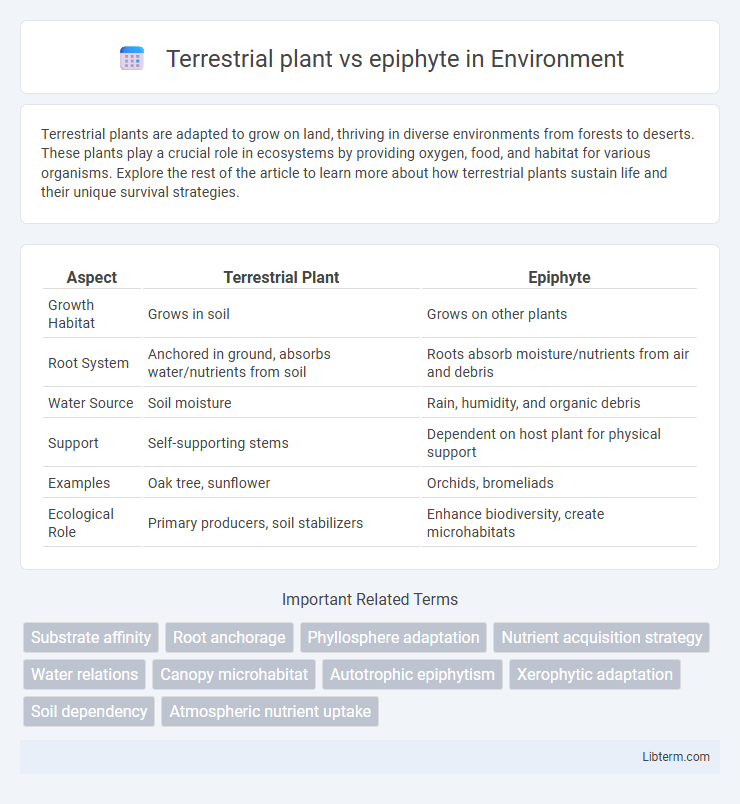Terrestrial plants are adapted to grow on land, thriving in diverse environments from forests to deserts. These plants play a crucial role in ecosystems by providing oxygen, food, and habitat for various organisms. Explore the rest of the article to learn more about how terrestrial plants sustain life and their unique survival strategies.
Table of Comparison
| Aspect | Terrestrial Plant | Epiphyte |
|---|---|---|
| Growth Habitat | Grows in soil | Grows on other plants |
| Root System | Anchored in ground, absorbs water/nutrients from soil | Roots absorb moisture/nutrients from air and debris |
| Water Source | Soil moisture | Rain, humidity, and organic debris |
| Support | Self-supporting stems | Dependent on host plant for physical support |
| Examples | Oak tree, sunflower | Orchids, bromeliads |
| Ecological Role | Primary producers, soil stabilizers | Enhance biodiversity, create microhabitats |
Introduction to Terrestrial Plants and Epiphytes
Terrestrial plants grow rooted in soil, relying on ground nutrients and water absorption through their extensive root systems. Epiphytes thrive by anchoring on other plants, accessing moisture and nutrients from the air, rain, and debris without soil contact. These adaptations highlight distinct ecological niches, influencing plant distribution and biodiversity in terrestrial ecosystems.
Defining Characteristics of Terrestrial Plants
Terrestrial plants are characterized by their growth in soil, where they develop extensive root systems for water and nutrient absorption, anchorage, and stability. These plants possess specialized tissues such as roots, stems, and leaves adapted for efficient photosynthesis and survival in soil-based environments. Their ability to access soil resources differentiates them from epiphytes, which rely on other plants for physical support and obtain moisture and nutrients from the air or debris.
Key Features of Epiphytes
Epiphytes are unique plants that grow on other plants, typically trees, without extracting nutrients from their host, distinguishing them from terrestrial plants that root in soil. They possess specialized adaptations such as aerial roots for absorbing moisture and nutrients from the air, and thick, waxy leaves to minimize water loss. Epiphytes play a crucial ecological role by contributing to biodiversity and providing habitats within forest canopies.
Root System Differences
Terrestrial plants develop extensive root systems that penetrate soil to absorb water and nutrients, providing structural stability and anchorage. In contrast, epiphytes possess specialized, often aerial roots adapted for anchoring onto host plants and efficiently capturing moisture and nutrients from the atmosphere or debris. These root system adaptations reflect their differing ecological niches and nutrient acquisition strategies.
Water and Nutrient Acquisition Strategies
Terrestrial plants absorb water and nutrients primarily through their root systems embedded in soil, utilizing root hairs and mycorrhizal associations to enhance uptake efficiency. Epiphytes, lacking direct soil contact, acquire moisture and nutrients from the air, rain, and debris by specialized structures such as trichomes, water-absorbing scales, or tank-like leaf rosettes that capture organic matter. These distinct strategies reflect adaptations to their respective environments, with terrestrial plants relying on soil ecosystems while epiphytes exploit atmospheric and canopy-derived resources.
Habitat and Environmental Adaptations
Terrestrial plants grow in soil and have root systems adapted for nutrient absorption and anchorage, thriving in environments with stable moisture and nutrient availability. Epiphytes inhabit tree branches or other plants, developing specialized roots for absorbing water and nutrients from the air and debris, enabling survival in nutrient-poor or fluctuating moisture conditions. These environmental adaptations allow epiphytes to exploit aerial habitats, reducing competition for light and space compared to ground-rooted terrestrial plants.
Photosynthesis and Light Utilization
Terrestrial plants rely on soil-based root systems to absorb water and nutrients, supporting photosynthesis through chloroplast-rich leaves adapted to varying light intensities. Epiphytes perform photosynthesis while anchored on other plants, often developing specialized leaf structures and chlorophyll concentrations to maximize light capture in shaded or filtered environments. Both exhibit distinct adaptations in chloroplast arrangement and light utilization efficiency, optimized for their unique ecological niches.
Reproductive Strategies and Dispersal
Terrestrial plants reproduce through seeds often dispersed by wind, water, or animals, relying on soil for root development and nutrient uptake to support seedling growth. Epiphytes develop specialized reproductive strategies such as producing lightweight seeds or spores adapted for wind dispersal, enabling colonization of elevated surfaces like tree branches without soil contact. Both types employ diverse dispersal mechanisms to enhance survival, but epiphytes uniquely optimize reproduction by exploiting aerial niches and minimal substrate requirements.
Ecological Roles and Interactions
Terrestrial plants anchor in soil, playing a critical role in nutrient cycling, carbon sequestration, and providing habitat for ground-dwelling organisms, while epiphytes grow non-parasitically on other plants, enhancing biodiversity by creating microhabitats in forest canopies and facilitating nutrient exchange within the ecosystem. Both plant types engage in complex interactions with pollinators, mycorrhizal fungi, and other species, but epiphytes uniquely contribute to forest stratification and moisture retention through their aerial adaptations. Their contrasting growth modes influence ecosystem dynamics, with terrestrial plants stabilizing soils and epiphytes expanding vertical habitat complexity.
Applications and Importance to Biodiversity
Terrestrial plants provide essential ecosystem services such as soil stabilization, carbon sequestration, and habitat formation, which support biodiversity and agricultural productivity. Epiphytes contribute to canopy biodiversity by creating microhabitats, enhancing nutrient cycling, and supporting diverse animal species in forest ecosystems. Both plant types are crucial for maintaining ecological balance and resilience in terrestrial and forest environments.
Terrestrial plant Infographic

 libterm.com
libterm.com